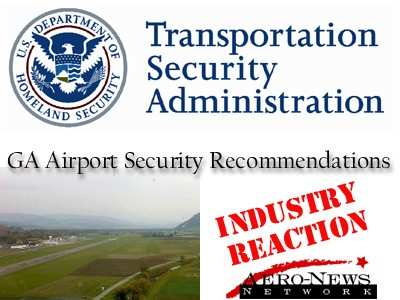Thu, May 20, 2004
Says It's "Pleased" At TSA Guidelines
 The TSA, after months of
preparation, released its General Aviation Security Recommendations
to the public earlier this week. Sent out as a TSA Information
Publication (IP), the guidelines are suggested security procedures
for general aviation airports and are not meant to be considered
mandatory.
The TSA, after months of
preparation, released its General Aviation Security Recommendations
to the public earlier this week. Sent out as a TSA Information
Publication (IP), the guidelines are suggested security procedures
for general aviation airports and are not meant to be considered
mandatory.
The guidelines are a result of months of work by the Aviation
Security Advisory Committee (ASAC) General Aviation Working Group
and the TSA. The ASAC developed a list of recommendations based on
best practices of the general aviation community. The TSA
incorporated each of those recommendations into the final guidance
document, with greater overall detail provided to eliminate
ambiguity.
"Overall, NATA is pleased with the guidance document and is
appreciative of the fact that the TSA took our recommendations into
consideration while drafting the IP," stated NATA president James
K. Coyne. "The document will be a great asset for those looking to
improve upon their already sufficient security plans."

The framework of the IP is seven functional areas –
personnel, aircraft, airports/facilities, surveillance, security
plans and communications and specialty operations. The IP also
provides a method for airports to determine their security needs,
realizing that there is no "one size fits all" approach when it
comes to airport security.
The TSA considers the IP a "living document" that will be
updated and modified as new security enhancements are developed and
as they receive additional input from the aviation industry.
One of the concerns raised with the issuing of this IP is how
the states will react. Early indications from some states are that
these recommendations could be codified into state law.
"Our only concern with the IP is that states may interpret this
document as regulatory framework and make the recommendations
mandatory," Coyne continued. "That is not the use for which the TSA
or the ASAC intended the document and the TSA and industry must
ensure that the states recognize this."
More News
Aero Linx: Model Aeronautical Association of Australia MAAA clubs are about fun flying, camaraderie and community. For over 75 years, the MAAA has been Australia’s largest fl>[...]
Touchdown Zone Lighting Two rows of transverse light bars located symmetrically about the runway centerline normally at 100 foot intervals. The basic system extends 3,000 feet alon>[...]
“Discovery and innovation are central to our mission at Virgin Galactic. We’re excited to build on our successful record of facilitating scientific experiments in subor>[...]
How To Get A Story On Aero-TV News/Feature Programming How do I submit a story idea or lead to Aero-TV? If you would like to submit a story idea or lead, please contact Jim Campbel>[...]
Student Pilot Reported That During Rotation, “All Of A Sudden The Back Of The Plane Kicked To The Right..." Analysis: The student pilot reported that during rotation, “>[...]
 ANN's Daily Aero-Linx (05.02.24)
ANN's Daily Aero-Linx (05.02.24) ANN's Daily Aero-Term (05.02.24): Touchdown Zone Lighting
ANN's Daily Aero-Term (05.02.24): Touchdown Zone Lighting Aero-News: Quote of the Day (05.02.24)
Aero-News: Quote of the Day (05.02.24) ANN FAQ: Contributing To Aero-TV
ANN FAQ: Contributing To Aero-TV NTSB Final Report: Cirrus Design Corp SR20
NTSB Final Report: Cirrus Design Corp SR20




